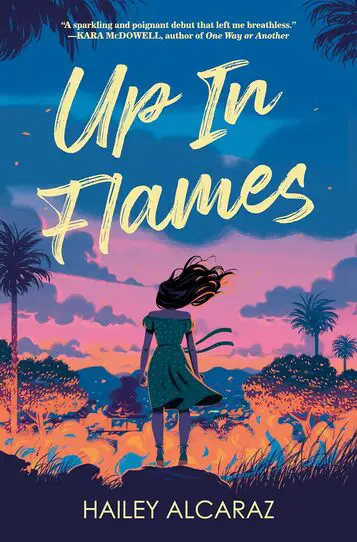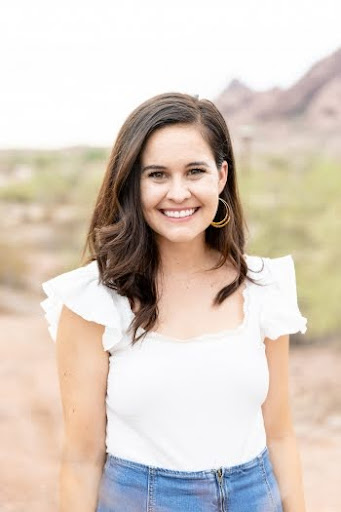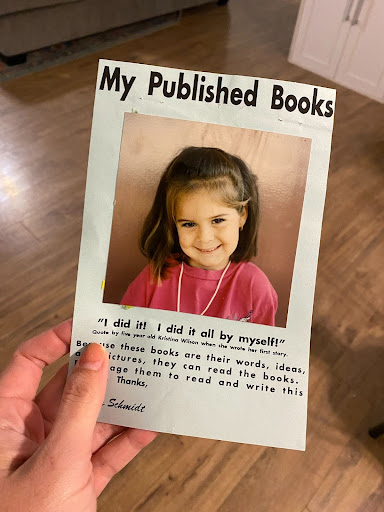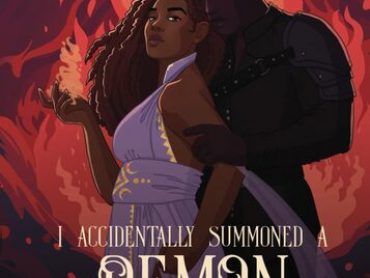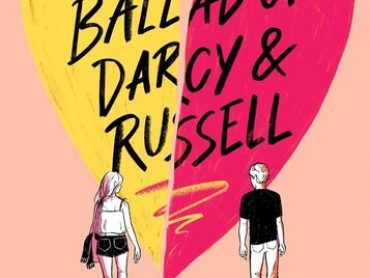Hailey Alcaraz’s debut novel Up In Flames draws upon her own experience as someone who has witnessed the devastation of the annual wildfires. The Mexican-American author penned the story of 18-year-old Ruby Ortega who is gorgeous, wealthy and entitled but who suddenly experiences loss through the wildfires that ravage her town. Ruby must struggle to find the grit and compassion to help her family and those less fortunate to rise from the ashes. We got to chat with Hailey to learn more about the inspiration behind the story, the writing process, and how she crafted Ruby’s character.
Young Entertainment: Do you remember the first time you wanted to be an author?
Hailey Alcaraz: My mom just sent me home with a box of childhood memorabilia that included many of my “first stories” from age four and up. She often says she remembers transcribing stories I’d tell her—at my instruction—before I could write. I’m attaching something I found from one of my first “books.” I mean it quite literally when I say it’s something I’ve always wanted and, in many ways, been working towards my entire life. There were seasons of my life where I wasn’t writing as regularly as I am now. My mom is also an author, and I grew up watching her pursue this dream. While I didn’t always understand the level of work that goes into publishing a book, I’ve lived my entire life knowing it was possible because I watched her do it. That’s been one of the most powerful, definitive lessons for me.
“This issue isn’t just related to wildfires, too; in all kinds of natural disasters, marginalized groups—like undocumented people—are impacted differently and often much more severely.”
YE: You take inspiration for Up In Flames from wildfires that often occur in the southwest, can you describe your experiences living in close proximity to such devastating fires?
HA: I live in Arizona, which is a very dry area. There are often wildfires in multiple communities throughout the year. My husband’s fire department monitors a nearby nature preserve. It’s not uncommon to see burned areas from recent wildfires, or smoke and road signs about what to expect along certain stretches of highway. It’s very sad to see both natural habitats and communities be impacted by this. It’s honestly never far from my mind because of where we live and what my husband does for a living. It’s an obvious and growing repercussion of climate change, and it’s a very real concern for the future.
YE: Your book also touches on undocumented people, and how the fires displaced them. Why was it important for you to have this be a part of your book and the story you are telling?
HA: I knew I wanted this story to have a social justice message. This largely comes from my background in political science, my affiliation with Teach For America, and the eight years I spent teaching middle school English. I wanted there to be a larger social message that informed and inspired young adults to awareness and action. As I researched wildfires, the issues of inequality became really clear. This issue isn’t just related to wildfires, too; in all kinds of natural disasters, marginalized groups—like undocumented people—are impacted differently and often much more severely. I wanted it to be something people learned about, especially given the increasing prevalence of wildfires.
YE: Which parts of your life did you specifically draw inspiration from for your book?
HA: Ruby’s identity as a white Latinx girl exploring her culture and privilege in the Southwest largely comes from my own lived experiences. Some of the questions she has about who she is as a biracial person are questions I’ve grappled with. Additionally, the central conflict surrounding wildfires came from my husband’s career in the fire service. It was my husband’s work stories that gave me the idea of focusing on wildfires, and he and his coworkers were really helpful in researching what wildland firefighters do and what wildfire damage entails.
One of the biggest challenges was thinking of an event that would destroy not only Ruby’s hometown, but her worldview.
YE: What was your writing process like?
HA: I don’t know if I have a writing process yet. And what I mean is, how much I write varies by season of life, and so far, every story I’ve written has had a pretty different approach. For Up in Flames, I brainstormed and grappled with the idea for a lot longer than I probably would now. I drafted for about a year. I didn’t really know if I could do this—write a book quite yet. Also because I had a baby during that time, and those things will certainly shake up your routines. Writing is mostly revising so after I wrote the first draft, I shared with friends and family for feedback, revised once I signed with my agent, and three or four more times with my editor. When I revise, I like to see things in hard copy and color coded, so I often make myself check lists and notes based on feedback to work through as I edit.
“If I can write a windows and doors book—the kind that allows young people to experience new things and/or see themselves within a story—then I’ve achieved my highest goal.”
YE: What are three words that you would use to describe the character of Ruby Ortega?
HA: Resilient, passionate, and stubborn.
YE: How would you describe Ruby’s character development throughout the book?
HA: I knew Ruby would be hard to like as I wrote her, but it’s surprised me just how much readers have had to warm up to her. I’ve nominated myself as an unlikeable female main character spokesperson, because it’s really fascinating what our limits are when it comes to young women. I think some of Ruby’s flaws would be more tolerable if she were a boy. (But that’s a soapbox saga for another day). She’s confident and driven, and yes, quite self-centered, too. She grows from a smart, privileged and immature young woman into one who has experienced hardship and tragedy and has turned those challenges into growth. By the end of the story, she has a new appreciation for her culture, her community, and her impact on others.
YE: What did you learn about yourself as a writer as you wrote this debut novel of yours?
HA: I learned so much about craft—specifically regarding pacing and dialogue–from my editor and agent. They really are so skilled and insightful. I feel fortunate that I’ve gotten to learn from their expertise. I’ve also learned a lot about my favorite tropes, and what makes a story special to me. I love a setting that is so important to the story. It’s almost like a character. I love love triangles and slow burn romances (pun intended). I love complicated female characters. I love endings that make you feel like the characters are continuing to live their lives beyond the final page. These are all things you’ll find in Up in Flames.
YE: What is another genre you hope to one day write a story in?
HA: I love coming-of-age stories, and see myself writing for teenagers and adults in their early twenties for the foreseeable future. I love the process of finding yourself at this age. However, my next book is a historical fiction story as well as a few that are contemporary and even romantasy.
YE: What is your favorite part of writing for a young adult audience?
HA: I was a middle school teacher for eight years, so I’ve seen the impact a good story can have on teenagers, and that’s something I’ll carry with me always. If I can write a windows and doors book—the kind that allows young people to experience new things and/or see themselves within a story—then I’ve achieved my highest goal.
YE: What was your favorite part of the writing process?
HA: I love revising. I love getting feedback from editors or critique partners and diving back into a story with a plan. I view writing as a very collaborative process, and seeing what other readers pulled out of your story, where they connected, where they had questions is almost like working through a puzzle. It’s where a story really starts to shine. Where it starts to feel like a book rather than a weird little Word document.
YE: What is a scene or a quote that is your favorite from Up In Flames?
HA: I love the ending. One of my favorite quotes comes from the last few pages:
“How could you truly love someone or something without seeing their flaws, too? And what was true love if it wasn’t working together—overcoming obstacles and looking hardship in the face—to be the best possible version you could be? Love wasn’t forcing things to be the way you wanted or idealizing them. Love was the fine balance between letting go and staying true to what was important. Love was work, but it was worth it.”
Consider This:
- Don’t be afraid to write what you know. If you are experiencing something in your own life that is important to you, include that in your character building and storytelling.
